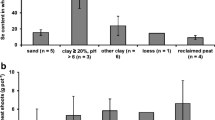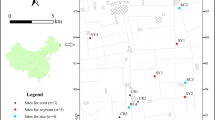Abstract
UK crops have a low selenium (Se) status, therefore Se fertilisation of wheat (Triticum aestivum L.) at 10 field sites was investigated and the effect on the content and speciation of Se in soils determined. Soil characterisation was carried out at each field site to determine the soil factors that may influence wheat grain Se concentrations in unfertilised plots. Soil samples were taken after harvest from each treatment to determine the fate and speciation of selenate fertiliser applied to soil. Wheat grain Se concentrations could be predicted from soil Se concentration and soil extractable sulphur (S) using the following regression model: Grain Se = a + b(total soil Se) + c(extractable soil Se) - d(extractable soil S), with 86 % of the variance being accounted for, suggesting that these properties control Se concentrations in grain from unfertilised plots. Extractable soil Se concentrations were low (2.4 – 12.4 µg kg−1) and predominantly consisted of selenite (up to 70 % of extractable Se) and soluble organic forms, whereas selenate was below the detection limit. Little of the added Se, in either liquid or granular form was left in the soil after crop harvest. Se fertilisation up to 20 g ha−1 did not lead to a significant Se accumulation in the soil, suggesting losses of Se unutilised by the crop.





Similar content being viewed by others
References
Adams ML, Lombi E, Zhao FJ, McGrath SP (2002) Evidence of low selenium concentrations in UK bread-making wheat grain. J Sci Food Agric 82:1160–1165
Bell PF, Parker DR, Page AL (1992) Contrasting selenate sulfate interactions in selenium-accumulating and nonaccumulating plant-species. Soil Sci Soc Am J 56:1818–1824
Broadley M, Alcock A, Alford J, Cartwright P, Foot I, S.J. F-T, Hart D J, Hurst R, Knott P, Meacham M C, McGrath S P, Mowat H, Norman K, Scott P, Stroud J L, Tovey M, Tucker M, White P J, Young S D and Zhao F J (2010) Selenium biofortification of high-yielding winter wheat (Triticum aestivum L.) by liquid or granular Se fertilisation. Plant Soil (in press)
Broadley MR, White PJ, Bryson RJ, Meacham MC, Bowen HC, Johnson SE, Hawkesford MJ, McGrath SP, Zhao FJ, Breward N, Harriman M, Tucker M (2006) Biofortification of UK food crops with selenium. Proc Nutr Soc 65:169–181
Elrashidi MA, Adriano DC, Workman SM, Lindsay WL (1987) Chemical-equilibria of selenium in soils - a theoretical development. Soil Sci 144:141–152
Fordyce F (2005) Selenium deficiency and toxicity in the environment. In: Selinus O, Alloway B, Centeno J, Finkelman R, Fuge R, Lindh U, Smedley P (eds) Essentials of Medical Geology. Elsevier, London, pp 373–415
Fordyce FM, Zhang GD, Green K, Liu XP (2000) Soil, grain and water chemistry in relation to human selenium-responsive diseases in Enshi District, China. Appl Geochem 15:117–132
Gissel-Nielsen G, Gupta UC, Lamand M, Westermarck T (1984) Selenium in soils and plants and its importance in livestock and human-nutrition. Adv Agron 37:397–460
Gupta UC (1995) Effects of selcote® ultra and sodium selenate (laboratory versus commercial grade) on selenium concentrations in feed crops. J Plant Nutr 18:1629–1636
Hartikainen H (2005) Biogeochemistry of selenium and its impact on food chain quality and human health. J Trace Elem Med Biol 18:309–318
Hawkesford MJ, Zhao FJ (2007) Strategies for increasing the selenium content of wheat. J Cereal Sci 46:282–292
Hoad SP, Russell G, Lucas ME, Bingham IJ (2001) The management of wheat, barley, and oat root systems. Adv Agron 74:193–246
Hopper JL, Parker DR (1999) Plant availability of selenite and selenate as influenced by the competing ions phosphate and sulfate. Plant Soil 210:199–207
Jackson BP, Miller WP (1999) Soluble arsenic and selenium species in fly ash organic waste-amended soils using ion chromatography inductively coupled plasma mass spectrometry. Environ Sci Technol 33:270–275
Keskinen R, Ekholm P, Yli-Halla M and Hartikainen H (2009) Efficiency of different methods in extracting selenium from agricultural soils of Finland. Geoderma 153:87–93.
Li HF, McGrath SP, Zhao FJ (2008) Selenium uptake, translocation and speciation in wheat supplied with selenate or selenite. New Phytol 178:92–102
Lin ZQ, Schemenauer RS, Cervinka V, Zayed A, Lee A, Terry N (2000) Selenium volatilization from a soil-plant system for the remediation of contaminated water and soil in the San Joaquin Valley. J Environ Qual 29:1048–1056
Martens DA, Suarez DL (1997) Selenium speciation of soil/sediment determined with sequential extractions and hydride generation atomic absorption spectrophotometry. Environ Sci Technol 31:133–139
McGrath SP, Cunliffe CH (1985) A simplified method for the extraction of the metals, Fe, Zn, Cu, Ni, Cd, Pb, Cr, Co, and Mn from soils and sewage sludges. J Sci Food Agric 36:794–798
Rayman MP (2000) The importance of selenium to human health. Lancet 356:233–241
Sippola J (1979) Selenium content of soils and timothy (Phyleum-pratense L) in Finland. Ann Agric Fenn 18:182–187
Spadoni M, Voltaggio M, Carcea M, Coni E, Raggi A, Cubadda F (2007) Bioaccessible selenium in Italian agricultural soils: Comparison of the biogeochemical approach with a regression model based on geochemical and pedoclimatic variables. Sci Total Environ 376:160–177
Stroud J L, McGrath S P and Zhao F (2009) Selenium speciation in soil extracts using LC-ICP-MS. Int J Environ Anal Chem (in press)
Stroud J L, Li H F, Lopez-Bellido F J, Broadley M, Foot I, S.J. F-T, Hart D J, Hurst R, Knott P, Norman K, Mowat H, Scott P, Tucker M, White P J, McGrath S P and Zhao F J (2010) Impact of sulphur fertilisation on crop response to Se fertilisation to applied soil. Plant Soil. doi:10.1007/s11104-009-0230-8
Terry N, Zayed AM, de Souza MP, Tarun AS (2000) Selenium in higher plants. Ann Rev Plant Physiol 51:401–432
Ylaranta T (1983) Sorption of selenite and selenate in the soil. Ann Agr Fenn 22:29–39
Zhao F, McGrath SP (1994) Extractable sulfate and organic sulfur in soils and their availability to plants. Plant Soil 164:243–250
Acknowledgements
Rothamsted Research is an institute of the UK Biotechnology and Biological Sciences Research Council. This project was sponsored by Defra through the Sustainable Arable LINK Programme (LK0974 grant). We thank Colin Gray and Sarah Dunham for their assistance collecting and analysing samples.
Author information
Authors and Affiliations
Corresponding author
Additional information
Responsible Editor: Peter Christie.
Rights and permissions
About this article
Cite this article
Stroud, J.L., Broadley, M.R., Foot, I. et al. Soil factors affecting selenium concentration in wheat grain and the fate and speciation of Se fertilisers applied to soil. Plant Soil 332, 19–30 (2010). https://doi.org/10.1007/s11104-009-0229-1
Received:
Accepted:
Published:
Issue Date:
DOI: https://doi.org/10.1007/s11104-009-0229-1




